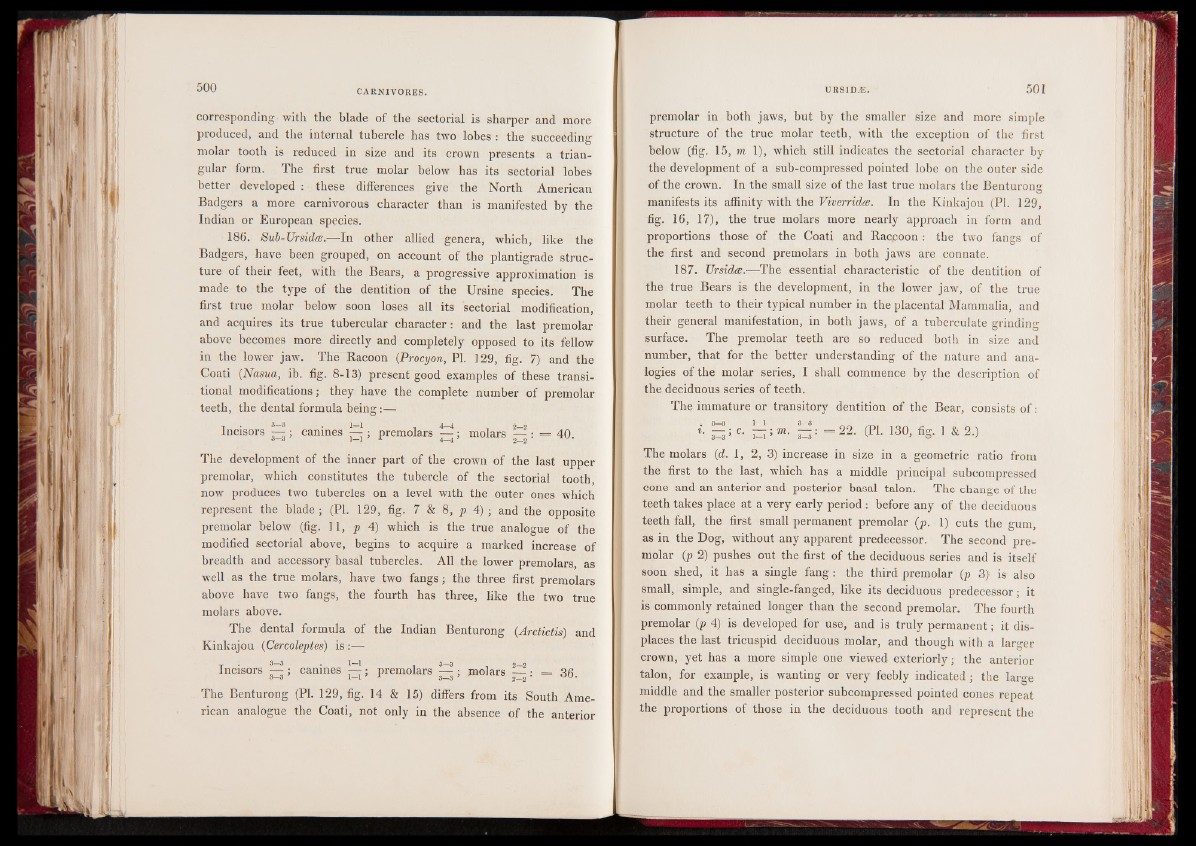
corresponding with the blade of the sectorial is sharper and more
produced, and the internal tubercle has two lobes : the succeeding
molar tooth is reduced in size and its crown presents a triangular
form. The first true molar below has its sectorial lobes
better developed : these differences give the North American
Badgers a more carnivorous character than is manifested by the
Indian or European species.
186. Sub-Ursides.—In other allied genera, which, like the
Badgers, have been grouped, on account of the plantigrade structure
of their feet, with the Bears, a progressive approximation is
made to the type of the dentition of the Ursine species. The
first true molar below soon loses all its sectorial modification,
and acquires its true tubercular character : and the last premolar
above becomes more directly and completely opposed to its fellow
in the lower jaw. The Racoon (Procyon, PI. 129, fig. 7) and the
Coati (Nasua-, ib. fig. 8-13) present good examples of these transitional
modifications; they have the complete number of premolar
teeth, the dental formula being:—
Incisors — ; canines § ; premolars — : molars — : = 40. o—uj 1—^1 x 4—4 2 2
The development of the inner part of the crown of the last upper
premolar, which constitutes the tubercle of the sectorial tooth,
now produces two tubercles on a level with the outer ones which
represent the blade ; (PI. 129, fig. 7 & 8, p 4) ; and the opposite
premolar below (fig. 11, p 4) which is the true analogue of the
modified sectorial above, begins to acquire a marked increase of
breadth and accessory basal tubercles. All the lower premolars, as
well as the true molars, have two fangs; the three first premolars
above have two fangs, the fourth has three, like the two true
molars above.
The dental formula of the Indian Benturong (Arctictis) and
Kinkajou (Cercoleptes) is :—
Incisors E j; canines H ; premolars — I molars — • = 3fi 3—3 1—1 -*• 3—3 2—2 *
The Benturong (PI. 129, fig. 14 & 15) differs from its South American
analogue the Coati, not only in the absence of the anterior
premolar in both jaws, but by the smaller size and more simple
structure of the true molar teeth, with the exception of the first
below (fig. 15, m 1), which still indicates the sectorial character by
the development of a sub-compressed pointed lobe on the outer side
of the crown. In the small size of the last true molars the Benturong
manifests its affinity with the Viverridas. In the Kinkajou (PI. 129,
fig. 16, 17), the true molars more nearly approach in form and
proportions those of the Coati and Racpoon: the two fangs of
the first and second premolars in both jaws are connate.
187. TJrsidce.—The essential characteristic of the dentition of
the true Bears is the development, in the lower jaw, of the true
molar teeth to their typical number in the placental Mammalia, and
their general manifestation, in both jaws, of a tuberculate grinding
surface. The premolar teeth are so reduced both in size and
number, that for the better understanding of the nature and analogies
of the molar series, I shall commence by the description of
the deciduous series of teeth.
The immature or transitory dentition of the Bear, consists o f:
*• c- m- S :S 22- (PL 130> % 1 & 2-)
The molars (d. 1, 2,3) increase in size in a geometric ratio from
the first to the last, which has a middle principal subcompressed
cone and an anterior and posterior basal talon. The change of the
teeth takes place at a very early period : before any of the deciduous
teeth fall, the first small permanent premolar (p. 1) cuts the gum,
as in the Dog, without any apparent predecessor. The second premolar
(p 2) pushes out the first of the deciduous series and is itself
soon shed, it has a single fang : the third premolar (p 3} is also
small, simple, and single-fanged, like its deciduous predecessor; it
is commonly retained longer than the second premolar. The fourth
premolar (p 4) is developed for use, and is truly permanent; it displaces
the last tricuspid deciduous molar, and though with a larger
crown, yet has a more simple one viewed exteriorly; the anterior
talon, for example, is wanting or very feebly indicated; the large
middle and the smaller posterior subcompressed pointed cones repeat
the proportions of those in the deciduous tooth and represent the